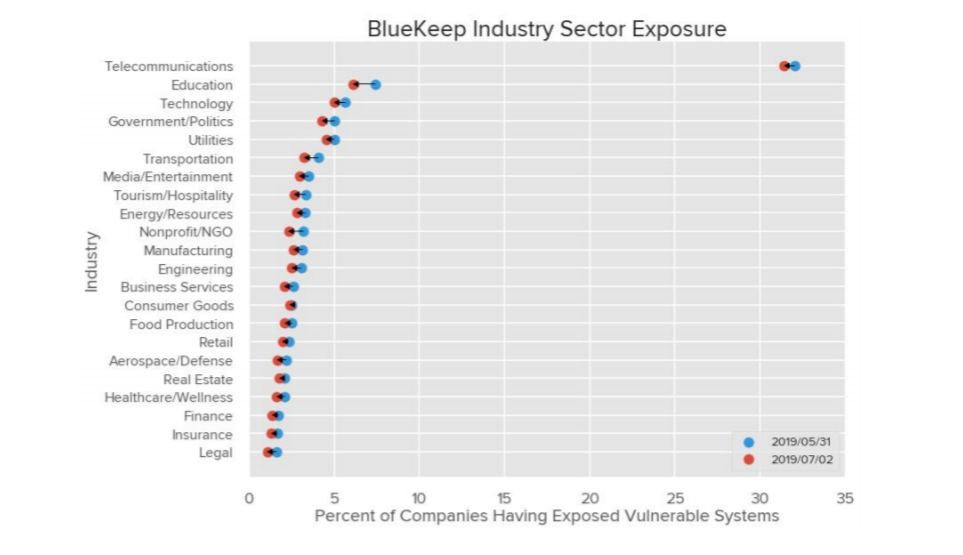Why the telecoms industry is particularly vulnerable to BlueKeep
The industry's exposure far exceeds any other, but it's not down to incompetence


The telecoms industry is considerably more vulnerable to the Windows BlueKeep exploit five months after its discovery than any other sector, according to new research.
BlueKeep is a remote code vulnerability discovered in May 2019 that affected nearly all versions of Windows and, if exploited, would give an attacker the highest possible privileges on a system.
The vulnerability was so severe that Microsoft released a security patch for it, including an out-of-band update for several versions of Windows that have gone end of life, such as Windows XP which hasn't received a security update since 2014.
Since the Department of Homeland Security and individuals in the private sector developed working exploits of the BlueKeep vulnerability, businesses have been scrambling to update their systems, but according to research from BitSight, over 800,000 systems still remain vulnerable representing just a 17% reduction in vulnerable systems since May.
The researchers said progress has been made across all the industries included in the study, but that telecoms is far more exposed than any sector, with more than 30% of systems still vulnerable to BlueKeep compared to education, the next most at risk area, at just over 5%.

BitSight attributed the huge discrepancy to the fact that "telecommunications companies usually host end-customer systems that they cannot upgrade themselves, which may explain the higher ratio for this industry sector".
"Telecommunications and education [industries] often provide transit services and thus many of the issues affecting those industries are on systems of their customers," the research read. "Residential networks are included as part of the telecommunication industry while in education, the largest group typically represents students."
Sign up today and you will receive a free copy of our Future Focus 2025 report - the leading guidance on AI, cybersecurity and other IT challenges as per 700+ senior executives
The industries most responsive when mitigating the vulnerability include the legal, insurance and financial services, all of which were the least vulnerable to BlueKeep in the first place.
The education sector experienced the most significant reduction in industry-wide vulnerability, as evidenced by the table above, but it still languishes behind nearly every other type of organisation.
It was also revealed that China is the country with the most vulnerable systems, closely followed by the US.
"China showed the highest absolute improvement by reducing the number of exposed vulnerable systems by 109,670 which represents a 23.9% decrease," read the report. "The United States followed suit by showing 26,787 fewer vulnerable systems exposed, representing a 20.3% decrease."
"However, there were a number of other countries that saw an increase in the number of exposed systems," the report added. "Most notably was South Korea showing an increase of 3,430 vulnerable exposed systems, a 14.5% increase, and Estonia with 146, a 32.2% increase."

Connor Jones has been at the forefront of global cyber security news coverage for the past few years, breaking developments on major stories such as LockBit’s ransomware attack on Royal Mail International, and many others. He has also made sporadic appearances on the ITPro Podcast discussing topics from home desk setups all the way to hacking systems using prosthetic limbs. He has a master’s degree in Magazine Journalism from the University of Sheffield, and has previously written for the likes of Red Bull Esports and UNILAD tech during his career that started in 2015.
-
 I couldn’t escape the iPhone 17 Pro this year – and it’s about time we redefined business phones
I couldn’t escape the iPhone 17 Pro this year – and it’s about time we redefined business phonesOpinion ITPro is back on smartphone reviews, as they grow more and more intertwined with our work-life balance
-
 When everything connects, everything’s at risk
When everything connects, everything’s at riskIndustry Insights Growing IoT complexity demands dynamic, automated security for visibility, compliance, and resilience
-
 Two Fortinet vulnerabilities are being exploited in the wild – patch now
Two Fortinet vulnerabilities are being exploited in the wild – patch nowNews Arctic Wolf and Rapid7 said security teams should act immediately to mitigate the Fortinet vulnerabilities
-
 Everything you need to know about Google and Apple’s emergency zero-day patches
Everything you need to know about Google and Apple’s emergency zero-day patchesNews A serious zero-day bug was spotted in Chrome systems that impacts Apple users too, forcing both companies to issue emergency patches
-
 Security experts claim the CVE Program isn’t up to scratch anymore — inaccurate scores and lengthy delays mean the system needs updated
Security experts claim the CVE Program isn’t up to scratch anymore — inaccurate scores and lengthy delays mean the system needs updatedNews CVE data is vital in combating emerging threats, yet inaccurate ratings and lengthy wait times are placing enterprises at risk
-
 IBM AIX users urged to patch immediately as researchers sound alarm on critical flaws
IBM AIX users urged to patch immediately as researchers sound alarm on critical flawsNews Network administrators should patch the four IBM AIX flaws as soon as possible
-
 Critical Dell Storage Manager flaws could let hackers access sensitive data – patch now
Critical Dell Storage Manager flaws could let hackers access sensitive data – patch nowNews A trio of flaws in Dell Storage Manager has prompted a customer alert
-
 Flaw in Lenovo’s customer service AI chatbot could let hackers run malicious code, breach networks
Flaw in Lenovo’s customer service AI chatbot could let hackers run malicious code, breach networksNews Hackers abusing the Lenovo flaw could inject malicious code with just a single prompt
-
 Industry welcomes the NCSC’s new Vulnerability Research Initiative – but does it go far enough?
Industry welcomes the NCSC’s new Vulnerability Research Initiative – but does it go far enough?News The cybersecurity agency will work with external researchers to uncover potential security holes in hardware and software
-
 Hackers are targeting Ivanti VPN users again – here’s what you need to know
Hackers are targeting Ivanti VPN users again – here’s what you need to knowNews Ivanti has re-patched a security flaw in its Connect Secure VPN appliances that's been exploited by a China-linked espionage group since at least the middle of March.